
In order to comprehend the current plight of the Medical Profession and the dark clouds that lie ahead it is necessary to understand the history of the “impaired physician movement” and the American Society of Addiction Medicine.
In 1985 the British sociologist G. V. Stimson wrote:
“The impaired physician movement is characterized by a number of evangelical recovered alcoholic and addict physicians, whose recovery has been accompanied by an involvement in medical society and treatment programs. Their ability to make authoritative pronouncements on physician impairment is based on their own claim to insider’s knowledge.”1
The impaired physician movement emphasizes disease and therapy rather than discipline and punishment and believes that addiction is a chronic relapsing brain disease requiring lifelong abstinence and 12-step spiritual recovery. The drug or alcohol abuser or addict is a person lacking adequate internal controls over his or her behavior; for his own protection as well as the protection of society external restraints are required including involuntary treatment.
The American Society of Addiction Medicine can trace its roots to the 1954 founding of the New York City Medical Society on Alcoholism (NYCMSA) by Ruth Fox, M.D whose husband died from alcoholism.
Finding that alcoholics in her psychoanalytic practice did not recover when she used conventional analytic approaches, she taught her patients about alcoholism as a disease and introduced “them to AA meetings held in her living room.”2
A number of physicians in the New York Medical Society were themselves recovering alcoholics who turned to Alcoholics Anonymous for care.3
The society, numbering about 100 members, established itself as a national organization in 1967, the American Medical Society on Alcoholism (AMSA).3
The group promoted the concept of alcoholism as a chronic relapsing disease requiring lifelong spiritual recovery through the 12-steps of AA.
By 1970 membership was nearly 500.2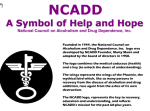
In 1973 AMSA became a component of the National Council on Alcoholism (NCA), now the National Council on Alcoholism and Drug Dependence (NCADD) in a medical advisory capacity until 1983.
“Abstinence from alcohol is necessary for recovery from the disease of alcoholism” became the first AMSA Position Statement in 1974.2
In 1985 ASAM’s first certification exam was announced. According to Dr. Bean-Bayog, chair of the Credentialing Committee:
“A lot of people in the alcoholism field have long wanted physicians in the field to have a high level of skills and scientific credibility and for this body of knowledge to be accredited.”2And in 1986 662 physicians took the first ASAM Certification Exam.
By 1988 membership was over 2,800 with 1,275 of these physicians “certified” as:
“having demonstrated knowledge and expertise in alcoholism and other drug dependencies commensurate with the standards set forth by the society.”4 “While certification does not certify clinical skill or competence,” the Board explained, “it does identify physicians who have demonstrated knowledge in diagnosis and treatment of alcoholism and other drug dependencies.”5Achieving “recognized board status for chemical dependence” and fellowships in “chemical dependency” are among the five-year objectives identified by the group. These are to come to fruition by “careful discussion, deliberation, and consultation” to “determine its form and structure and how best to bring it about.”5
The formation of ASAM State Chapters begins with California, Florida, Georgia, and Maryland submitting requests.6
In 1988 the AMA House of Delegates votes to admit ASAM to the House. According to ASAM News this “legitimizes the society within the halls of organized medicine.”2
In 1989 the organization changes its name to the American Society of Addiction Medicine (ASAM).2
Since 1990, physicians have been able to list addiction medicine as a self-designated area of practice using the specialty code “ADM.”
By 1993 ASAM has a membership of 3,500 with a total of 2,619 certifications in Addiction Medicine.
The Membership Campaign Task Force sets a goal to double its membership of 3,500 to 7,000 by the year 2000 to assure “the future of treatment for patients with chemicals. It represents a blueprint for establishing addiction medicine as a viable entity.”7
Ninety physicians become Fellows of the American Society of Addiction Medicine (FASAM) in 1996 “to recognize substantial and lasting contributions to the Society and the field of addiction medicine.”8
Among the honorees are Robert DuPont, G. Douglas Talbott, Paul Earley, and Mel Pohl. In addition to at least five consecutive years of membership and certification by the Society, Fellows must have “taken a leadership role in ASAM through committee service, or have been an officer of a state chapter, and they must have made and continue to make significant contributions to the addictions field.”8
The American Board of Addiction Medicine (ABAM) is formed in 2007 as a non-profit 501(C)(6) organization “following conferences of committees appointed by the American Society of Addiction Medicine” to “examine and certify Diplomats.”9
In 2009 National Institute on Drug Abuse (NIDA) Director Nora Volkow, M.D., gives the keynote address at the first ABAM  board certification diploma ceremony.10
board certification diploma ceremony.10
According to an article in Addiction Professional “Board certification is the highest level of practice recognition given to physicians.”
“A Physician membership society such as ASAM, however, cannot confer ‘Board Certification,’ ” but a“ “Medical Board such as ABAM has a separate and distinct purpose and mission: to promote and improve the quality of medical care through establishing and maintaining standards and procedures for credentialing and re-credentialing medical specialties.”
The majority of ASAM physicians meet these requirements by “working in a chemical dependency treatment facility, taking continuing medical education courses in addiction, or participating in research.”11
“In the United States accredited residency programs in addiction exist only for psychiatrists specializing in addiction psychiatry; nonpsychiatrists seeking training in addiction medicine can train in nonaccredited ‘fellowships,’ or can receive training in some ADP programs, only to not be granted a certificate of completion of accredited training.”11
Specialty recognition by the American Board of Medical Specialties, fifty Addiction Medicine Fellowship training programs and a National Center for Physician Training in Addiction Medicine are listed as future initiatives of the ABAM Foundation in 2014.
The American Society of Addiction Medicine’s mission is to “establish addiction medicine as a specialty recognized by professional organizations, governments, physicians, purchasers, and consumers of health care products, and the general public’12
In this they have succeeded.
And in the year 2014 G.V. Stimson’s characterization of the “impaired physician movement” remains as accurate and apt as it was in 1985. But the “number of evangelical recovered alcoholic and addict physicians” has increased dramatically (outnumbering Addiction Psychiatry by 4:1) and their involvement in “ medical society and treatment programs” has been realized and enforced through the state Physician Health Programs and their “PHP-approved’ assessment and treatment centers.
Their “ability to make authoritative pronouncements on physician impairment…based on their own claim to insider’s knowledge” has become public policy and sanctified by Regulatory Medicine -essentially the Word of the Lord.
And the 1953 Alcoholics Anonymous prophecy that “With one arm around the shoulder of religion and the other around the shoulder of medicine, we might change the world” is also coming to pass.
But the world is not changing for the better as that arm around the shoulder of religion has its fingers deep in the pockets of the multi-billion dollar drug and alcohol testing and assessment and treatment industries. And the arm around the shoulder of medicine has its fingers clamped tightly around its throat; a stranglehold in full throttle suffocating the Profession of Medicine with no meaningful opposition I can see.
- Stimson GV. Recent developments in professional control: the impaired physician movement in the USA. Sociology of health & illness. Jul 1985;7(2):141-166.
- Four Decades of ASAM. ASAM News. March-April 1994, 1994.
- Freed CR. Addiction medicine and addiction psychiatry in America: Commonalities in the medical treatment of addiction. Contemporary Drug Problems. 2010;37(1):139-163.
- . American Medical Society on Alcoholism & Other Drug Dependencies Newsletter. Vol III. New York, NY: AMSAODD; 1988:12.
- Ursery S. $1.3M verdict coaxes a deal for doctor’s coerced rehab. Fulton County Daily Report. May 12, 1999b 1999.
- . AMSAODD News. Vol III. New York, NY: American Medical Society on Alcoholism & Other Drug Dependencies; 1988.
- Membership Campaign Update. ASAM News. Vol VIII: American Society of Addiction Medicine; 1993:11.
- . ASAM News. Vol 12. Chevy Chase, MD: American Society of Addiction Medicine; 1997:20.
- http://www.abam.net/about/history/.
- Kunz KB, Gentiello LM. Landmark Recognition for Addiction Medicine: Physician certification by the American Board of Addiction Medicine will Benefit all Addiction Professionals. Addiction Professional. 2009. http://www.addictionpro.com/article/landmark-recognition-addiction-medicine.
- Tontchev GV, Housel TR, Callahan JF, Kunz KB, Miller MM, Blondell RD. Specialized training on addictions for physicians in the United States. Substance abuse : official publication of the Association for Medical Education and Research in Substance Abuse. Apr 2011;32(2):84-92.
- http://www.asam.org/about-us/mission-and-goals.




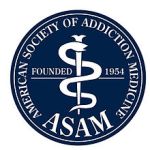
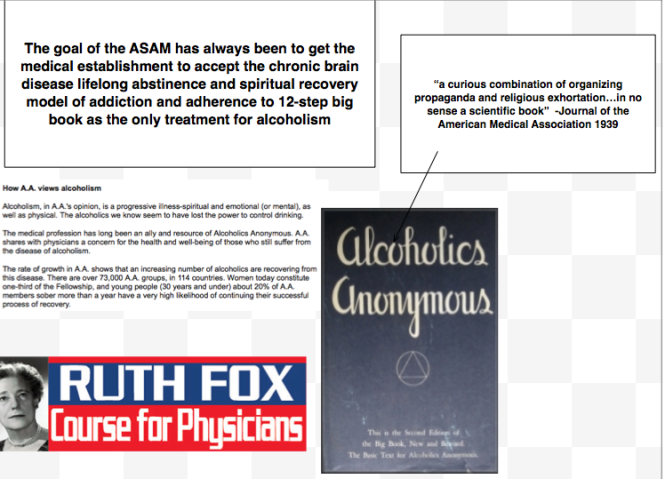
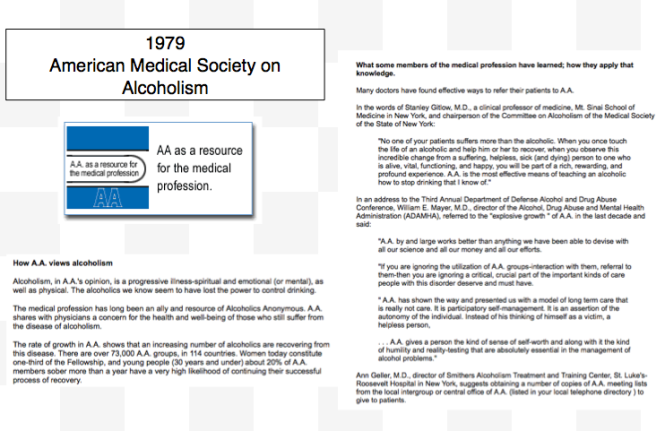
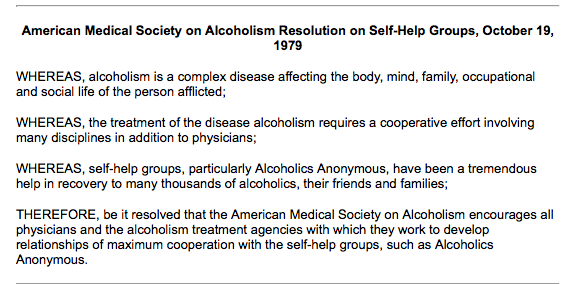
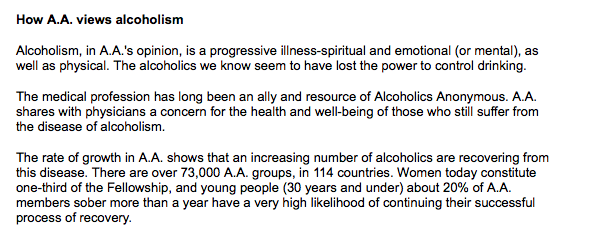





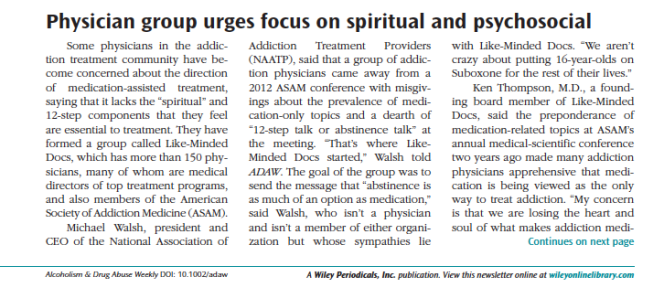

[…] Disrupted Physician 101.1: The “Impaired Physician Movement” and the History of the Amer…. […]
LikeLike
Organized medicine isn’t likely aware that the “recovery movement” that they endorsed decades ago (on the basis of its original benevolent principles) has been secretly taken over by power-crazed, entrepreneurial thugs masquerading as white-coated squeaky clean rehabilitated physicians espousing the 12 step religion. Sadly also, they doesn’t likely care, certainly not sufficiently to raise their voices and protect their membership from PHPs’ death grip. And this has been accomplished, in part, by PHPs being embraced by the medical societies themselves.
In fact, the NC Medical Society (NCMS) prides itself on declaring that NCPHP is its offspring. However, NCMS was admonished by the NC State Auditor in its recent performance audit of NCPHP for playing no oversight role as it was supposed to have been doing. In fact, it was found that NCPHP has been operating with no oversight at all – not by the medical society, not by the medical board and not even by its own board of directors. (The audit report is available at: http://www.ncauditor.net/EPSWeb/Reports/Performance/PER-2013-8141.pdf)
So, in essence, for medical societies to speak out and take ownership necessarily exposes their own role in PHPs’ pervasive wrongdoing – and therefore ownership for all the consequential damage and financial liability – for its gross violation of civil liberties; anti-competitive practices; operating without a corporate medical license; breaches of privacy; unwarranted interruption of medical practices; and defamation (to name just a few of their egregious violations).
Another key reason why organized medicine has given free rein to PHPs is what could best be compared to the “outsourcing of stinky garbage work.” I think it’s fair to say that the vast majority of physicians don’t have significantly impairing problems with alcohol, drugs, mental illness or disruptive behavior (though with the current climate of healthcare and the lack of supportive resources, such can only be expected to increase). For that minority who do develop these problems, PHPs came on the scene originally as genuinely concerned do-gooders (in the good sense), originating from their inception as “impaired physician” / “wellness” committees of local hospitals and medical societies, to help those who had succumbed to the myriad pressures of a life in medicine and developed significantly problematic illnesses. Organized medicine basically said “well, we don’t want to deal with those problem docs (read: “losers”), and since you benevolent PHP good fellows say you want to take it on, have at it … it’s all yours.” And have at it they most definitely did. (Of course, it does cross one’s mind whether medical societies might be reaping some financial benefit as well from PHPs’ “preferred facility” referrals.)
Organized medicine’s (and governments’ and the general public’s) position has essentially been one of free-market outsourcing. (It’s the same dynamic that has occurred in the justice system – privately owned-and-operated prisons and “rehabilitation centers” – essentially domestic, capitalist-inspired, profit-driven versions of extraordinary rendition.) And the reason why it’s been allowed to flourish is that the attitude of the outsourcing agencies has been a) “it doesn’t affect me but only those ‘unfortunates'”; and b) “surely, there are enough checks and balances in place (e.g. due process, transparency and accountability) to ensure that they won’t mistreat these ‘unfortunates.'” And, voila, as an organization, I emphatically swipe my palms together, ridding myself of this annoying little problem of dealing with the outcasts and happily go about my business. Until, that is, I become one of the “unfortunates.”
It is only then that one realizes, as increasing numbers of physicians (and PAs and many other healthcare professionals) have realized, that the two assumptions were deeply flawed. It doesn’t just affect “unfortunates” because, in a due process-deprived, hidden-from-public-view, government sanctioned system, we’re all liable to be ensnared by the monster (e.g. witness government surveillance). And, in fact, not only are there not enough checks and balances in the outsourced system, there are none! And worse, not only are there none, but there’s no consequence to these power-and-profit-driven enterprises’ limitless abuses. Because this Frankenstein was actually a patchwork of multiple creators, no one is really in charge of it. And, while operating essentially invisibly, it’s essentially been given free rein by each of the state legislatures who naively beknighted it and tied its functions to the also unchecked powers of the regulatory licensing boards, giving it sovereign immunity to boot! (Legislatures too likely share the same operational assumptions about outsourcing the handling of the “unfortunates.”)
I believe it’s important to take a systems perspective on this. No “one” person is driving this, though each of the players is doing their part to work the system to their advantage. If I ran a for-profit long term addictions treatment facility (and one that is entirely above board), you can be assured that I’d do all I could to strengthen my referral pipeline. If I ran a for-profit prison, I’d do all I could to keep it full occupancy, including cozying up to co-owners in the justice system to ensure a steady stream of “referrals.”* Why? Because I can. There’s nothing holding me back. (So much for the idyllic notions of self-restraint and self-motivated organizational integrity.) Personal and organizational integrity? Bah, humbug! What’s that have to do with running a profitable business where I’ve invested a lot in making connections? “Besides,” I say to myself, “I’m not responsible for the way the system works!”
(* There recently was one such case of a judge sentencing juveniles to a facility s/he co-owned.)
Phenomena like this are like hurricane storm systems. They’re created and intensified by multiple atmospheric forces – cool moist air here, warm and dry there, massive fronts themselves influenced by their own multi-causal dynamics. Did any one element cause this hurricane? I believe our challenge is to approach this as a powerful system which is a confluence (perhaps even a “conspiracy”) of forces.* A deranged system not unlike a malignant cancer which operates stealthily for so long until at last it manifests itself and presents itself for intervention. An increasing number of us are, unfortunately, the victims of this invasive cancer, our career and life assaults are its overt manifestations.
(* For these purposes, I believe a confluence becomes a conspiracy or collusion when two forces intentionally unite.)
Toward that end, various physicians across the country have formed organizations devoted to examining this problem of medical licensing board and PHP abuses of authority and violations of physicians’ due process. (For one, see The Center for Physician Advocacy, currently at http://www.PhysicianRights.wordpress.com . They are hoping to serve as an information and support resource for physicians and their families who are newly ensnared in the board and PHP regulatory web. [Disclaimer: I am on their steering committee.]) And there are numerous others, often single physicians desperately presenting their case to the public. And a stalwart in the battle has been the American Association of Physicians and Surgeons; they’ve been going to battle with various state medical boards over their conduct of sham peer review for a number of years.(http://www.aapsonline.org/index.php/article/sham_peer_review_resources_physicians/) Even they, with their numerous well researched pleading in multiple cases, have encountered remarkable opposition.
It’s going to take all of our efforts to end this nightmare and bring this behemoth under control. And I believe it can be done. Because it has to be done. Because we know that this insane and voracious PHP “professional evaluation and treatment” movement – currently proselytizing AA zealotry and operating in the form of a joint PHP-Medical Board cabal (with full, unquestioned and unchallengeable endorsement by the medical board) – will soon break out of the confines of the healthcare industry and move on to every other profession and regulatory agency and employee assistance program (EAP) in the country where there is profit to be had, posing benevolently as the 12 step empowered answer to their “problematic professionals.” (And keep in mind, in such a concealed, due process-deprived environment, “problematic” doesn’t just mean “ill.” It also includes anyone deemed to be a “problem.”)
Lastly, I’ve closely followed your case of being ensnared by PHS and being a victim of forensic lab fraud, and I’m sorry for what you and your family have had to endure. I truly applaud your tireless efforts, Michael, as you delve into the workings of this rampaging Frankenstein. It has clearly destroyed your career and is ravaging many other physicians’ careers and families and the wellbeing of these physicians’ patients. And it’s only going to be by collaborative action that we will be able to confront it and prevail. In doing so, we might even restore integrity to the physicians’ wellness movement that has been so thoroughly hijacked by this organized racket.
Kernan Manion, MD
LikeLike
Reblogged this on Center for Physician Advocacy and commented:
This is from “Disrupted Physician,” Michael Langan’s excellent blog exploring the PHP cabal and its tight association with ASAM and its exclusive endorsement of the AA model. Elsewhere, he documents his prolonged detention in the PHP system and Board restrictions on his license based on documented lab fraud.
LikeLike
[…] Douglas Talbott is a prototypical example of an “impaired physician movement” physician–in fact in many ways he may be considered the”godfather” of the […]
LikeLike
Thanks for an interesting and informative history of the AA and PHP movement. In the past I admitted patients to a facility within a hospital that treated addiction, although cigarettes and caffeine were still readily available. The folks who ran the facility were strongly AA, very dogmatic, and highly opinionated. We had weekly meetings regarding the patients. I recall one meeting when one of the psychologists stated my patient’s drug and alcohol problem was related to the music he listened to. When questioned further he stated it was due to rock bands like Black Sabbath. I asked what music he listened to and he stated country western. As I pointed out, if he actually listened to Black Sabbath’s lyrics he would understand that they were antidrug, antiwar, antiviolence, etc. and that country music was strewn with alcohol and drug references and that the musicians were far from angels. Not sure he ever made the connection.
The problem for physicians is that we are now prisoners of a system that is just as dogmatic as AA. State Medical Boards run the system. There is only one way to practice medicine and that is their way. They want machines that follow algorithms and from what I read that is where we are heading. You give the machine your symptoms. It asks further questions. It can even examine you with video and pressure sensors. It does the algorithm and you get treatment.
The Medical Boards have no distinct oversight from State government, physicians or the public. There is no ombudsman available to physicians if they have concerns about fairness or integrity of process. There is no complaint process in place for the physicians or the public regarding Medical Board concerns/”malpractice”. The Medical Boards are allowed to run shoddy investigations, withhold information and deny Due Process. They are protected by your State DOJ, by the bureaucratic structure that put them in place and to date by the State and Federal courts. They have a “license to kill”, that is destroy your career, and in some circumstances destroy families or individuals themselves including suicide. Lawyers either don’t have the power or will to challenge these State actors. Instead, most lawyers have you sign onto whatever the Medical Board wants, mainly because there is no other recourse for a physician at this time. You will be forced to sign a confession, such as a Stipulated Order, if you desire to keep your license. Unfortunately, most times this information goes to the National Practitioner Data Bank (NPDB) which means the physician’s career is basically ended. You can’t get a job, contract with an insurance company or get malpractice insurance. There is no expungement from the NPDB at this time.
In public, the Medical Boards always put on their “do gooder” hat. They are there for “public safety” is their motto. Yet they are not concerned about public safety as they would opine. I alone have numerous examples of them neglecting public safety for unknown reasons in Oregon. It seems in Oregon, they will viciously attack any physician who refuses to sign a document full of lies or who demands fairness, integrity and due process. Anyone who stands up for themselves is a target.
I and others have formed an organization to combat these inequities. The link is http://physicianrights.wordpress.com/. Please contact us with any concerns or information.
My own personal experience with the Oregon Medical Board, along with my Federal Court experience, is documented at http://drdovervsomb.weebly.com/.
LikeLike
[…] or Dupont’s Keynote Speech before the Drug and Alcohol Testing Industry Association. Illegitimate and irrational power is very dangerous. But no one is really paying attention. This is just a […]
LikeLike
Reblogged this on Disrupted Physician and commented:
The American Society of Addiction Medicine’s mission is to “establish addiction medicine as a specialty recognized by professional organizations, governments, physicians, purchasers, and consumers of health care products, and the general public’12
In this they have succeeded.
And in the year 2014 G.V. Stimson’s characterization of the “impaired physician movement” remains as accurate and apt as it was in 1985. But the “number of evangelical recovered alcoholic and addict physicians” has increased dramatically (outnumbering Addiction Psychiatry by 4:1) and their involvement in “ medical society and treatment programs” has been realized and enforced through the state Physician Health Programs and their “PHP-approved’ assessment and treatment centers.Screen Shot 2014-11-18 at 10.11.55 AM
Their “ability to make authoritative pronouncements on physician impairment…based on their own claim to insider’s knowledge” has become public policy and sanctified by Regulatory Medicine -essentially the Word of the Lord.
And the 1953 Alcoholics Anonymous prophecy that “With one arm around the shoulder of religion and the other around the shoulder of medicine, we might change the world” is also coming to pass.
But the world is not changing for the better as that arm around the shoulder of religion has its fingers deep in the pockets of the multi-billion dollar drug and alcohol testing and assessment and treatment industries. And the arm around the shoulder of medicine has its fingers clamped tightly around its throat; a stranglehold in full throttle suffocating the Profession of Medicine with no meaningful opposition I can see.
LikeLike
Reblogged this on Chaotic Pharmacology and commented:
“The impaired physician movement is characterized by a number of evangelical recovered alcoholic and addict physicians, whose recovery has been accompanied by an involvement in medical society and treatment programs. Their ability to make authoritative pronouncements on physician impairment is based on their own claim to insider’s knowledge.” –G. V. Stimson (1985)
LikeLike
[…] The Constitution reported that doctors entered the program under threats of loss of licensure “even when they would prefer treatment that is cheaper and closer to home.” The paper also noted that Ridgeview “enjoys unparalleled connections with many local and state medical societies that work with troubled doctors,” “licensing boards often seek recommendations from such groups in devising an approved treatment plan,” and those in charge are often “physicians who themselves have successfully completed Ridgeview’s program.” […]
LikeLike
[…] understandable overview of the principles of Medical Ethics. As moral entrepreneurs the “impaired physician movement” and its offshoots have used the logical fallacy of appeal to authority to convince […]
LikeLike
[…] regulation or accountability. Moreover, the authority bestowed on this group is both illegitimate and irrational. The Federation of State Physician Health Programs is composed of American Society of Addiction […]
LikeLike
[…] regulation or accountability. Moreover, the authority bestowed on this group is both illegitimate and irrational. The Federation of State Physician Health Programs is composed of American Society of Addiction […]
LikeLike
[…] http://disruptedphysician.com/2014/11/16/disrupted-physician-101-1-the-impaired-physician-movement-a… […]
LikeLike
[…] Disrupted Physician 101.1: The “Impaired Physician Movement” and the History of the Amer…. […]
LikeLike
[…] Zero-Tolerance for Forensic Fraud and Political Abuse of Psychiatry Necessary. Any and all forensic fraud should be met with Zero-tolerance. State PHPs are colluding with commercial drug testing labs and “PHP-approved” assessment and treatment centers this same scaffold is being used in many states. Doctors are dying because of it. State Physician Health Programs (PHPs) are organized under the Federation of State Physician Health Programs (FSPHP). The FSPHP arose from the American Society of Addiction Medicine and the history can be seen here. […]
LikeLike
[…] 1985 the British Sociologist G.V. Stimson wrote of a new form of professional control in the United States that had emerged in the preceding decade whose “success rests on the ability […]
LikeLiked by 1 person
[…] Douglas Talbott is a prototypical example of an “impaired physician movement”physician–in fact in many ways he may be considered the”godfather” of the […]
LikeLike
[…] 1985 the British Sociologist G.V. Stimson wrote of a new form of professional control in the United States that had emerged in the preceding decade whose “success rests on the ability […]
LikeLike
[…] Douglas Talbott is a prototypical example of an “impaired physician movement” physician–in fact in many ways he may be considered the”godfather” of the […]
LikeLike
[…] “With one arm around the shoulder of religion and the other around the shoulder of medicine, we might change the world.”—Twelve Steps and Twelve Traditions, AA World Services, Inc (1953). In…Source: Disrupted Physician 101.1: The “Impaired Physician Movement” and the History of the Amer… […]
LikeLike
[…] 1985 the British Sociologist G.V. Stimson wrote of a new form of professional control in the United States that had emerged in the preceding decade whose “success rests on the ability […]
LikeLike
[…] Source: Disrupted Physician 101.1: The “Impaired Physician Movement” and the History of the Amer… […]
LikeLike
[…] Douglas Talbott is a prototypical example of an “impaired physician movement”physician–in fact in many ways he may be considered the”godfather” of the […]
LikeLike
[…] “The impaired physician movement is characterized by a number of evangelical recovered alcoholic and addict physicians, whose recovery has been accompanied by an involvement in medical society and treatment programs. Their ability to make authoritative pronouncements on physician impairment is based on their own claim to insider’s knowledge.”1 […]
LikeLike
[…] Disrupted Physician […]
LikeLike